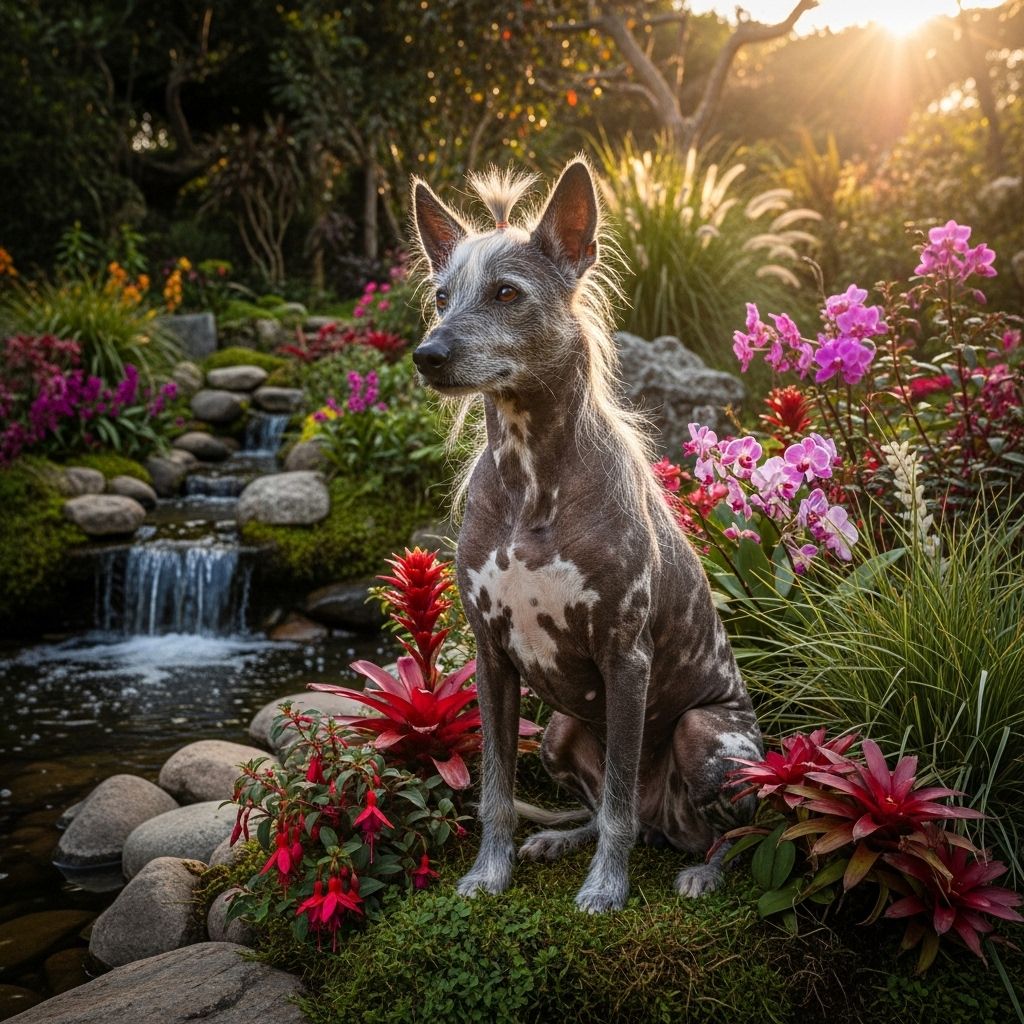Peruvian Inca Orchid: Ancient Elegance, Modern Grace
A centuries-old sighthound that combines elegance, loyalty, and unique care requirements.

Peruvian Inca Orchid: An Ancient Canine Gem
The Peruvian Inca Orchid (also known as the Peruvian Hairless Dog or Perro Sin Pelo del Perú) is a rare and captivating breed renowned for its hairless beauty, devoted nature, and rich historical roots in pre-Columbian Peru. These elegant and sensitive sighthounds are cherished today both as companions and cultural treasures.
History and Origins of the Peruvian Inca Orchid
The legacy of the Peruvian Inca Orchid stretches back more than a thousand years, with artistic depictions found on Moche, Chimú, and Vicus ceramics dating to around 750 AD. The breed was a companion to nobility during the Inca Empire, and it’s believed that the Incans—and cultures that predated them—valued the dog for both companionship and spiritual symbolism. When Spanish conquistadors arrived, they classified the Peruvian Inca Orchid as one of six native dog breeds of the empire.
In the modern era, the breed is celebrated as a living symbol of Peru, recognized as part of the nation’s cultural heritage. In 2001, the Peruvian government granted the dog official protected status. Internationally, the Fédération Cynologique Internationale (FCI) and kennel clubs such as the American Kennel Club (AKC) now recognize the breed, helping preserve its distinct genetics and storied past.
Historical highlights:
- Depictions on ancient pottery and art from multiple pre-Inca cultures
- Associated with royalty and spiritual beliefs among Indigenous peoples
- Became a symbol of national pride and Peruvian heritage
Appearance: The Elegant and Unique Sighthound
The Peruvian Inca Orchid boasts a striking and unmistakable look. The breed’s most iconic trait is hairlessness: most dogs are born without fur, though a minority (10–20%) are “coated” with short or medium hair thanks to a recessive gene. Both types can occur in the same litter.
- Body: Sleek, athletic, and graceful, typical of sighthound breeds.
- Build: Slim and elegant, with a long neck and deep chest; tail is thin and slightly curved.
- Ears: Prominent and upright or semi-pricked.
- Skin/Coat:
- Hairless: Usually completely bare except for sparse tufts on the head (sometimes a “mohawk”), feet, and tail. Skin feels warm and smooth.
- Coated: Short or medium hair, sometimes with feathering on ears, neck, and tail. Both varieties are equally accepted in the breed standard.
- Color: All colors accepted—white, pink, tan, gray, black, brown, with solid or spotted patterns.
- Size: Three sizes recognized:
- Small: Height 10–16 inches; Weight 9–18 pounds
- Medium: Height 16–20 inches; Weight 18–26 pounds
- Large: Height 20–26 inches; Weight 26–55 pounds
This breed’s hairlessness leads to some secondary characteristics, like incomplete dentition—many Peruvian Inca Orchids have some missing teeth, a genetic trait linked with the hairless gene. Their skin is often pigmented and feels distinctly warm to the touch because of a slightly higher body temperature compared to coated breeds.
Temperament: Loyal Companions with a Sensitive Soul
The Peruvian Inca Orchid is beloved for its affectionate, loyal, and intelligent personality. Understanding their temperament is key to creating a harmonious home:
- Devoted to family: Forms deep bonds with owners and immediate family. Tends to shadow their humans closely, craving companionship.
- Reserved with strangers: May seem shy or aloof when meeting new people. Early socialization helps reduce wariness.
- Protective but not aggressive: May bark to alert but is rarely confrontational.
- Quiet and calm indoors, agile outdoors: While docile inside, they love to sprint and explore when given the space.
- Excellent with respectful children: Often forms strong bonds with older kids who understand canine boundaries. Sensitive temperament means tolerance may be limited with very small or boisterous children.
- Good with other dogs: Social and playful with other canines, especially if socialized young.
- Prey drive: Retains instincts as a sighthound and may chase small animals. Supervision with cats and avoidance of homes with small prey pets advised.
Are Peruvian Inca Orchids Good Family Dogs?
These dogs are best suited for families looking for a loving, attentive companion. Their sensitive nature means they thrive in homes that provide gentle handling and a predictable routine. They make excellent partners for active singles, couples, or families with older children.
Behavioral Traits
- Quick to learn: Intelligent and eager to please; responds well to positive reinforcement training.
- Separation anxiety: Strongly attached to their people and can develop anxiety if left alone for long periods.
- Cleanliness: Fastidious and relatively odor-free, with minimal shedding in the coated variety.
Health and Lifespan: What Owners Should Know
Overall, the Peruvian Inca Orchid is a healthy breed with a typical lifespan of 12–14 years. However, prospective owners should be aware of some specific health considerations:
- Sun sensitivity: Hairless dogs are prone to sunburn, skin cancer, and dryness. Owners should apply dog-safe sunscreen and provide protective clothing as needed.
- Skin care: Gentle bathing and moisturizing are essential to prevent irritation. Avoid harsh chemicals that could inflame sensitive skin.
- Missing teeth: Most hairless dogs are missing some teeth, which can affect chewing; soft diets may be helpful.
- Temperature regulation: Susceptible to chills in cold weather; needs warm bedding and protection in winter.
- General robustness: Not prone to the joint or heart issues sometimes seen in larger sighthounds.
Routine veterinary care, early health screening, and responsible breeding are crucial for maintaining the breed’s health.
Exercise and Living Requirements
The Peruvian Inca Orchid, despite its sighthound lineage, is not excessively energetic but benefits from daily exercise and mental stimulation:
- Walks and Playtime: Regular walks, interactive play, and occasional sprints in a secure area keep these dogs fit and happy.
- Indoor Companions: Not suited to outdoor-only living—the breed prefers being close to family and may become distressed if left outside.
- Mental Enrichment: Enjoys puzzle toys, training games, and learning new tricks.
- Dog Sports: Agile enough for sports like obedience, rally, and canine agility.
- Leash Safety: Sighthounds are fast, and a loose Peruvian Inca Orchid may chase after small creatures; always use a leash or secure area outside.
Grooming: Minimal But Essential
Despite being largely hairless, this breed has unique grooming needs:
- Skin care: Gentle baths every 1–2 weeks; use a mild, moisturizing dog shampoo.
- Moisturizing: After bathing, apply dog-safe moisturizer to prevent skin from drying and cracking.
- Sun protection: Use sunscreen or sun-protective shirts in bright sunlight.
- Warmth: Provide sweaters or dog coats in chilly weather, as they lack insulating fur.
- Dental care: With frequent missing teeth, soft toothbrushes and regular dental care visits are important.
- Nail trimming: Keep nails short for comfort and agility.
For “coated” variety dogs, minimal brushing suffices, as they do not shed heavily.
Training and Socialization
The breed is highly trainable thanks to its intelligence and willingness to please. To ensure a confident, well-mannered dog, focus on early socialization and gentle, positive training methods:
- Expose puppies to new people, places, and sounds early and often.
- Use positive reinforcement—treats, praise, and toys.
- Keep training sessions upbeat and never harsh; sensitivity means this breed can be easily discouraged by negativity.
- Enroll in puppy kindergarten or basic obedience classes for the best results.
Popular Names for the Peruvian Inca Orchid
- Pedro
- Teresa
- Eva
- Carlos
- Luna
- Lucas
- Bella
- Chester
- Mia
- Sam
Peruvian Inca Orchid vs. Xoloitzcuintli: A Table of Comparisons
| Feature | Peruvian Inca Orchid | Xoloitzcuintli |
|---|---|---|
| Origin | Peru | Mexico |
| Main Trait | Mostly hairless (some coated) | Mostly hairless (some coated) |
| Size | Small, Medium, Large | Toy, Miniature, Standard |
| Temperament | Loyal, sensitive, reserved | Devoted, calm, reserved |
| Recognized by AKC | Yes | Yes |
Is the Peruvian Inca Orchid Right for You?
This breed is ideal for:
- Families seeking a devoted and gentle companion.
- Owners able to provide the extra care required for hairless breeds (skin, teeth, warmth).
- Households where someone is often home; the dog bonds closely and dislikes prolonged solitude.
- People who appreciate ancient breeds and unique canine heritage.
It may not be ideal for homes with:
- Small prey pets (rabbits, hamsters, etc.), due to high prey drive.
- Very young, unpredictable children.
- Potential owners unable to commit to skin care and sun protection.
Frequently Asked Questions (FAQs)
Q: Are Peruvian Inca Orchids hypoallergenic?
A: They are one of the most hypoallergenic breeds due to minimal fur and dander, but people with severe allergies should still spend time with the breed before adopting.
Q: How long do Peruvian Inca Orchids live?
A: Their average lifespan is 12–14 years, with some individuals living even longer with excellent care.
Q: Can Peruvian Inca Orchids tolerate cold weather?
A: No, hairless PIOs are very sensitive to cold and require warm coats and protection during chilly weather to prevent hypothermia.
Q: Do they make good apartment dogs?
A: Yes, as long as they receive daily walks and enough mental stimulation, they adapt well to apartment living due to their calm, quiet nature indoors.
Q: Are they good with first-time dog owners?
A: They can be, especially if first-time owners are prepared for their special care needs and are willing to invest time in positive training.
Summary: The Living Treasure of Peru
The Peruvian Inca Orchid stands as one of the world’s oldest, most distinctive, and most affectionate dog breeds. With their unique hairless (or occasionally coated) appearance, loving disposition, and deep cultural roots, they make memorable companions for those able to meet their unique care needs. For dog enthusiasts drawn to rarity, history, and elegance, the Peruvian Inca Orchid offers a singular canine experience—one both ancient and timeless.
References
Read full bio of Srija Burman












